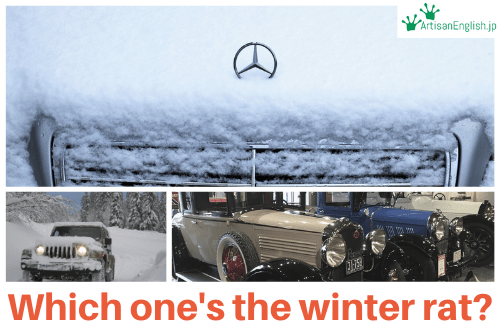
YouTube / iTunes / Spotify / Radio Public / Pocket Casts / Google Podcasts / Breaker / Overcast
Listen to ArtisanEnglish.jp posts & lesson intros here.
Word of the Day: Winter rat
The time to put away your lovely Corvette convertible and switch to driving your winter rat has come and gone.
Christmas is fast approaching, and New Year’s is not far behind.
Then we will enter the depth of winter, and everyone knows Corvettes and convertibles, even more so, are not suitable for snowy weather.
Some people in North America, especially those who live near the Great Lakes in both The US and Canada, have a second car they call their winter rat.
No, it’s not a rat rod. That is something entirely different.
A winter rat is a junky, old, cheap car that people who can afford two cars drive around in the winter because they want to protect their regular daily driver from the salty winter roads.
North Americans put salt on the streets in winter to melt the ice for those who don’t know.
Keep in mind that winter rats are probably only for those who can afford to store a nicer car all winter long.
The rest of us drive the same vehicle all year long, spring or fall, rain or shine, salty roads or not.
I suppose if your fair-weather daily driver is a Bugatti Veyron, your winter rat could be a Mercedes Benz G-wagon.
We’re talking about the one percent of the one-percenters here.
To tell the truth, I’m not sure if the Japanese have anything similar to a winter rat, but I do know most households in Wakayama have two cars, and perhaps a minitruck, with a Honda Super Cub or scooter for shorter runs.
Hey, when the (in)convenience store is 9km away, everyone in the family has a mode of transportation.
Flesch-Kincaid Readability Test
This post is understandable by someone with at least an 8th-grade education (age 13 – 14).
On the Flesch-Kincaid reading-ease test, this post scores 67.
The easier a passage is to read, the higher the score on a scale of 0 – 100.

